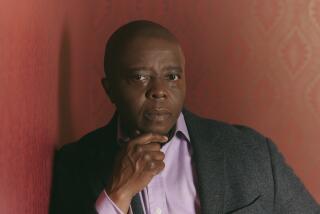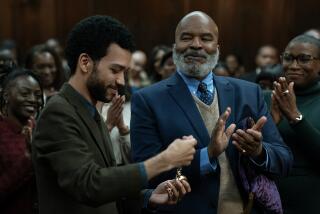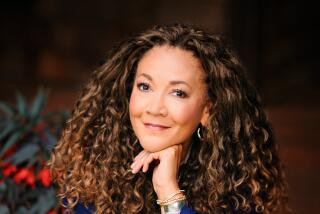‘In the Heat of the Night’ Sends a Message : Popular NBC Series Gives Positive Role Model of Race Relations, Says Producer
- Share via
The only hate mail that the cast and crew of the NBC television series “In the Heat of the Night” have received so far has come from white racists complaining that the show features too many blacks.
Those who took the satiric bigotry of Archie Bunker to heart apparently don’t approve of Carroll O’Connor--the man who once portrayed their Everyman hero--now sharing equal footing with Howard Rollins, his black co-star and partner in small-town crime fighting.
These critics seem to be a distinct minority, however. The drama about policemen in Sparta, Miss., has become so popular in its Tuesday-night time slot that it has forced ABC to knock the once-celebrated “Moonlighting” out of the lineup and bring in ratings-heavyweight “Roseanne.” (See accompanying story.)
Yet the letters point up two realities of contemporary life that the producers of the cop show, based on Norman Jewison’s 1967 Academy Award-winning film, hope their program underscores on a regular basis.
First, that by portraying black and white characters working together, socializing together, co-existing relatively effortlessly in an atmosphere of mutual respect, friendship and intimacy, “In the Heat of the Night” provides a positive role model of race relations that executive producer David Moessinger hopes eventually will “seep into the American consciousness.”
Second, that it is a much needed message; though the “whites only” signs have long since been burned for firewood, racial prejudice--at least the subtle, slippery, inbred variety--is still alive and well.
A recent study on race relations commissioned by the NAACP showed that many whites continue to stereotype blacks. More than one-third of the whites surveyed said they believe that “blacks tend to have less ambition than whites” and one-fifth said that “blacks breed crime.”
That survey came on the heels of a flurry of articles documenting how poorly black Americans fared during the eight years of Ronald Reagan’s presidency. Black life expectancy has dropped in recent years; black urban areas are riddled with violence, drugs and unemployment; and the economic disparity between whites and blacks has increased dramatically.
“I was one of those in the ‘60s that was out marching for civil rights,” said Jeri Taylor, supervising producer of the series, “and I was one of those who thought the major work had all been done. When we (Taylor and her husband, Moessinger) decided to do the show, we took research trips to the South, and we saw that there had been an enormous amount of change. But we also came back with a renewed vigor and the realization that there is still a lot more to be done. There is still this deeply entrenched racism. And addressing that became a much larger element in our thinking about the show.”
“What makes race relations a constant in our show is the two lead characters--one is white and one is black,” Moessinger said. “Whether they are angry at each other, whether they’re happy or sad, we’re showing the interaction of two men who are trying to do the best in life. If we never put one race issue into it, if we never said one word about it, the message is there because it’s showing how people ought to interrelate, how they ought to work together, how they ought to get along.”
Virgil Tibbs (Rollins), the Philadelphia transplant who is Sparta’s black chief of detectives, and his boss, Police Chief Bill Gillespie (O’Connor), carry on a working and social relationship that most people would envy. They have their differences and disagreements--Gillespie is an intuitive, touchy-feely kind of cop, while Tibbs is a big-city transplant who takes a more rational, scientific approach to solving murders. And Gillespie, because of his age and experience as a small-town Southern police chief, will even insist that he knows how the blacks of his town think and behave better than his black colleague from the North.
But unlike in the 1967 film, which starred Sidney Poitier and Rod Stieger, the relationship is never hostile. Tibbs, Gillespie and the rest of the show’s regulars are basically colorblind.
“We couldn’t go around yelling racial epithets at each other week after week,” explained O’Connor, who also serves as story editor and has been critical of the series for adapting worn, big-city cop show story lines to this series’ small-town locale. “That would be too ugly. And by the same token, we can’t have dialogue that makes a point of how well they are getting along. It has to be done through the acting. The audience has to see how they get along, how they behave with each other in a professional and personal way.
“It would be a mistake to get into serving up lessons: ‘Look at this. We’re showing you how blacks and whites should get along.’ People who are rigid tend to grow more rigid when television tells them what to do. If we show them these characters acting toward each other in a reasonable, friendly, intimate way, it may change their minds a little bit.”
But in a phone interview from Covington, Ga., where the series is filmed, Rollins, one of the few black actors to star in a dramatic television series, seemed downright hostile to the idea of making specific statements about black-white relations or creating a character that would be seen solely as a positive role model for blacks.
“People are bored with that crap,” Rollins said. “If people don’t know by now that there are, have been and will be racial problems in this country, then I’m not the spokesperson on that issue. I feel much more strongly about presenting a real human character. I’m interested in having a white kid look at my character and say, ‘I like that guy. I’d like to be a homicide detective.’ It’s good if a black kid looks at it and says that too. But I want to focus on the human angle of the character and the relationship.
“Everyone knows that racial prejudice does not work. So rather than talking about it, it becomes a matter of doing something about it. And when a racial issue comes up, our show does that by dealing with it from a human point of view and by showing the ridiculousness of it.”
Moessinger and Taylor, who supervise or write all of the scripts, said they have consciously tried to inject various race issues, as well as a variety of serious human issues in general, into their cops-and-murderers stories. Among the topics they’ve tackled since the series premiered last spring are interracial dating, incest and Old-South bigotry versus the racial tolerance of today’s South. Future episodes will focus on the alleged rape of a black woman by a white police officer and the epidemic of black teen-age pregnancies.
Even when the writers attempt to address a black and white issue, however, the cop-show, who-done-it necessities of the format sometimes lead it astray. In a recent episode, Tibbs and his wife were asked by a white minister to integrate his lily-white church. When the minister was murdered, the police suspected that the crime was racially motivated. After both Tibbs and Gillespie put the episode’s guest racist in his place by calling him a “maggot” and throwing him in jail, it turned out that an old white doctor had murdered the minister for having an affair with his daughter.
“This is a cop show, and we do have to pay attention to some of those kinds of conventions much more than we’d like to,” Taylor said. “If we did just heavy-issue shows, it might become didactic and preachy and the public probably wouldn’t like it. But if you support those issues with some mystery and misdirection and that kind of juice, it drives the story along. Sometimes we have to do a light cop show episode. You have to have a balance.”
While he would like to think that the widespread popularity of the show reflects an America that is ready to accept this sort of a black-white relationship, Moessinger isn’t so sure.
“We’re a cop show,” Moessinger said. “I don’t think (our popularity) is a statement that blacks and whites are getting along great out there. What would happen if we weren’t dealing with a police force and people weren’t getting murdered and beaten up? Would they still tune in? If the show had been called ‘The Tibbs Family,’ we wouldn’t be on.”
More to Read
The complete guide to home viewing
Get Screen Gab for everything about the TV shows and streaming movies everyone’s talking about.
You may occasionally receive promotional content from the Los Angeles Times.






